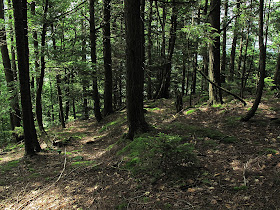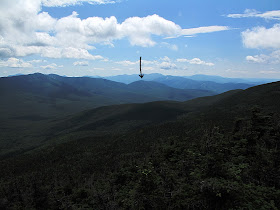 |
| Early July 4th morning I was wandering around the Forrest Ridge condominium complex near Lincoln, NH, looking for a relatively easy route for bushwhacking up to Franconia Ridge from Lincoln. I had tried variations back in the fall from another starting point without any luck but came out of it a little wiser. The route I was going to try on Thursday was to circle upwards around Big Coolidge Mt. staying in hardwood forest as much as possible and avoiding the dense coniferous growth of spruce and fir near the treeline. |

On Thursday my y primary purpose was to find a small "opening", a small place to push through that dense coniferous growth
so I can scoot over the ridge and slip down effortlessly into the Pemi on the
east side of Mt. Flume. After an hour of searching I found a likely lead
consisting of an grown-over path heading uphill and into the woods (first photo). Mt.
Coolidge was heavily logged about 120 years ago and I expected to find some of
the dugway roads loggers used to bring the logs to the mills and use them as a resource. The one in the photo above
was close to the Condominium parking lot running east and west. There were foot
prints and tire tracks in a muddy sections indicating it's being used recreationally by folks at the condos.

Higher up the mountain flank I found more remnants of older
logging roads that probably dated back to the 1890s. Records indicate that both
Little and Big Coolidge Mts. along with Whaleback (Osseo) and Potash Knob were
all logged off in 1893-1894 by J. E. Henry and Sons of Lincoln, NH (from Bill
Gove excellent book, J. E Henry's Logging Railroads,
published by Bondcliff Books in 1998). In some cases, as on the Hancocks, the dugway roads circled the
mountains. Dugway logging roads were the most expedient system for moving logs
downhill. Crews simply dug into the mountain pulling the soil away from the
uphill side across to the downhill side until a wide enough, level roadway existed
which eventually got packed down from use. The track in the second photo above is a good
example.
 |
| It got steeper and steeper until I came to the base of a high cliff with huge boulders stacked around the base that seemed to be in competition with the trees. There were large trees, one or two measuring 3 feet in diameter, consisting of white ash, sugar maple, beech and yelllow birch growing in and
around the boulder field at the bottom of the cliff while white birch and
balsam fir grew on the cliff face taking root in cracks and on ledges. The cliff is about 100 feet high. |
 |
| Hey, I was here first! |
 |
| Downhill roots of an ash tree that measured 95 inches in circumference, or 2 feet 8 inches. The downhill roots are more thicker and longer on the older, larger tree as a necessary means to steady the tree against the inevitability of gravity. |
|
|
 |
| Further to the west and away from the cliff the terrain and forest looked like this and was easy to navigate through. |
 |
This is looking up the cliff face. It's barely visible through the foliage but dramatic all the same.
I'm going to say it's weathered Conway granite. Most of the cliff face was encrusted with lichen and moss. I have to say that I'm drawn to cliffs and find them both fascinating (mesmerizing) and exciting to be near, if not on. Like the mountains themselves, cliffs, particularly high, dramatic ones, like the Eiger, or El Capitain that represent the ultimate challenge, draw one to them making the pulse beat a little faster. |
 |
| Edging around the side of the cliff..... |
 |
| .....and topping out. Finding the cliff was an interesting start to my explorations for the day and created some unexpected excitement for me. |
 |
| At the top of the cliff there was an open forest, mostly of small balsams, and a great deal of moss on top of the rock cap. The space created by the trees, moss and sunlight was breath taking. |
 |
The reasons for wanting to do this bushwhack is to return to the forest in a purposeful way, to relax in it and move through it quietly without an agenda, without any pretense. I have to admit that I know little about the forest inspite of all the time I've spent in it. Learning about the forest requires patience and insight and being able to slow down and savor it. I can run up mountains as fast as I can go which is fun and relaxing. On this trip I want to go slowly. I think it will take 3-4 days, maybe longer. It's only about 25 miles and some of the bushwhacking will be relatively easy while some of it will be slow and painstaking, naturally.

To help us get oriented I'll use this photo I took from North Kinsman on Friday, July 5th. The arrow points at Big Coolidge Mt. (3294 ft. asl) with its long southwestern ridge running down to the right and a deep notch to the left. You can see the patterns of conifer forest areas and the hardwood areas (lighter green). From that notch up to the summit of Mt. Flume which is right next to Mt. Liberty, the two high points on the left, you can see those patterns of darker and lighter greens. I was trying to stay in the hardwoods, the lighter green. Behind the arrow is Tripyramid with Osceola just to the right of the arrow, Mt. Hitchcock lower and to the right, and Sandwich Dome to the right of that. Carrigain is peeking over the ridge to the left of Liberty and Flume. |
 |
| Working my way up out of the notch towards the upper ridge. |
 |
| The hike reminded me a lot of my climb up Mt. Osseo last October (2012) in a variety of ways. The diversity of vegetation was one, terrain was another, the exposure was similar so the light was also the same, and the height. Osseo is only 300 feet higher than Big Coolidge. |
 |
| I was amused by my proclivity to see "evidence" of human activity. Often there were features that were similar to trails, at least for short distances, that I immediately responded to and that made me feel less lonely even though the entire effort I was engaging in was to get away from the very thing. We are creatures of habit. At any rate I was back in the coniferous zone but at this point it was open. There was a lot of digging and clawing with feet and hands to get up through the soft duff and I often slipped backwards two steps for each step I climbed. In the hardwood areas I was amazed at the depth of the leaf litter which in some places was a foot. |
 |
| A key thing to remember is that this forest, the forest ecosystem we're looking at in the White Mountains today, is the replacement for the forest ecosystem that was here for a very long period of time, perhaps as long as 10,000 years, but was then destroyed in a few hundred years. The modern forest has only been here for perhaps 100 to 200 years and is still "young" and in a constant state of transitioning. The old forest was a legacy of the massive ice sheets that covered this part of the world for hundreds of thousands of years and only ablated 11,000 years ago. The new forest, in striking ways, is a legacy of that old, post-glacial forest ecosystem. We don't have an exact history of the old forest and where it was in its development. Was it vibrant and healthy, or was it past its climax and in decline? We have an idea of some of the changes in the land and climate and the adaptations and succession that occurred when some species died off and other species moved here. We have a good idea of how climate changes impacted the entirety of that vast forest ecosystem that stretched across the continent. We know the history of the "modern" forest pretty well. Scientific documentation of the post-glacial forest began with the first European "contact" between 1500 and 1600 by navigators like Jacques Cartier and Samuel de Champlain. Both these individuals were notable for making scientific observations: transcribing invaluable descriptions offered by natives, collecting, identifying, and describing specimens of much of the flora and fauna of the northern forest. Much of the forest witnessed by Verrazanno, Champlain, Cartier, and others, particularly the natives of that period, is gone. It disappeared in the blink of an eye. That the modern forest has survived its first 100-200 years is certainly cause for celebration. I hope it's still here, still evolving, 9,900 years from now. |
 |
| This is what takes the wind out of your sails. I carried and briefly used a bike helmet and the kind of knee pads used by roller derby competitors to make crashing through this forest web a little more feasible. |
 |
| Or this. This is actually easier to negotiate. It reminded me of the bushwhack on Mt. Deception two years ago and is typical of what the upper west-facing ridges look like generally--a lot of wind damage. When I see this I remember the hard work of the early trail builders here in the Whites and remain in awe of what they accomplished with hand tools. |
 |
| This is what finally stopped me. It was hot, I was tired. To make it worse I was carrying 5 quarts of water; two for me on the hike and three to drop that I could pick up on later on the bushwhack to save time and energy. I drank two and drained the others before descending. |
 |
| At any rate I had reached my turn-around time and was ready to head back down after a casual lunch which was when I consumed one of the water bottles and the water came pouring out of the pores in my skin as if I was a sieve. |
 |
| I altered my return course to explore more to the north and west of my two ascents. I found it easier heading due West course but it was not exactly from the starting point I wanted. I might have to compromise on that. The woods were stunning in the early afternoon light. In the valley it was in the 90s all day but under the heavy foliage (healthy foliage) it was much cooler. |
 |
| I stopped often to listen and watch. This photo is static. It's frozen within an instant of time. Sitting there, though, was to be aware of movement, particularly the bright shards of flickering sunlight that were animated by the wind combing through the leaves in the upper canopy. Added to that was the movement of birds and insects and the trees themselves. Peachy. |
























No comments:
Post a Comment